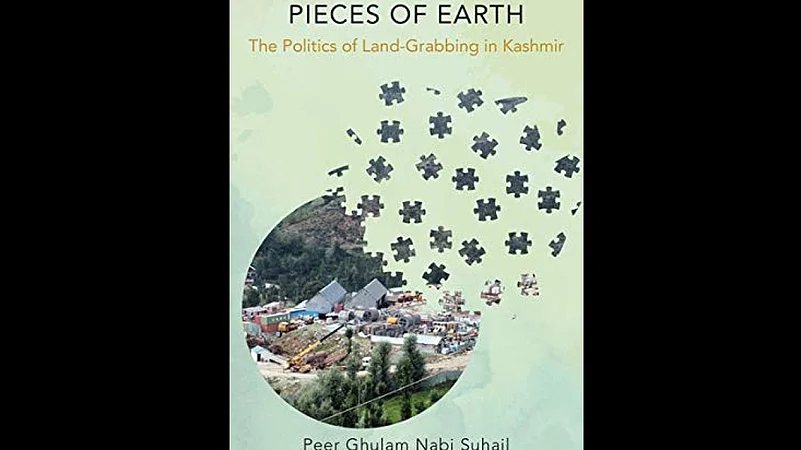Pieces of Earth: The Politics of Land-Grabbing in Kashmir
By Peer Ghulam Nabi Suhail
Oxford University Press,
pp. 212, Rs 695
The glacial burst in Uttarakhand that consumed 67 lives in February last year caused worries across the regions that have not died down. While people have begun questioning the hydropower-led development in ecologically fragile regions like the Himalayas, it is sending very disturbing signals to the people who can potentially be affected, in a wholesale devastation, by this man-made developmental disaster.
In less than a decade, Uttarakhand has witnessed the unimagined fury and such catastrophes leave lessons. Sadly, J&K follows the similar trajectory of development that brought ruins to another Himalayan region. On January 03, 2021, J&K government signed MoUs with the NHPC “for the implementation of 850 MW Ratle HEP and 930 MW Kirthai-II HEP; execution of Sawalkot HEP (1856 MW), Uri-I (Stage-II) (240 MW) and Dulhasti (Stage-II) (258 MW)”. Borrowing lessons from Uttarakhand, the slogan of “power surplus” J&K must be examined by a question: for whom? At what cost?
Since August 2019, the discourse over Kashmir is ‘set’ at ‘development’ and ‘democracy’. The government has flooded the restricted public sphere with the slogans and advertisements of ‘development’. Such a fanfare attention fundamentally misses an indispensable dimension of it, that is, the people who become victims of this ‘development,’ which is not in sync with their rights.
In this background, Peer G. N. Suhail’s Pieces of Earth: The Politics of Land-Grabbing in Kashmir (Oxford, 2018) is a powerful intervention that successfully punches the dominant discourse on the one hand, and attempts to locate the concerns — of livelihood, culture, land and identity — of the peasantry in ‘water politics’ of India and Pakistan, on the other. It adequately shows the neglect of unruly and unjust land-grabbing in conflict zones in the existing global scholarship of land-grapping. The massive land-grabbing in Kashmir (for security and development purposes) deserves scholarly attention and rightfully so. International contestation over the land and the resources, heavy militarisation and local disturbance do make Kashmir sui-generis and, as such, is a stand-out case in India.
There are three reasons to examine land-grabbing phenomenon in Kashmir: the hydroelectricity projects lead to dispossession and displacement of people; growing importance of regional studies for understanding the sub-national economies; and finally hydroelectricity power projects have become the bone of contention between India and Pakistan (21-23). The existing scholarship on Kashmir does not address these vital questions.
Additionally, the massive construction of dams in the entire Himalayan region poses challenges that range from geo-strategic, geo-cultural to natural disasters. The author propels us to revisit the dominant prism of writing history and understanding the ‘silences’ of social life. With a profound use of ethnographic methods, it records and brings forth the multiple yet overlapping exercises of the dispossessed ‘peasants’ who consciously choose their weapons of resistance. They avoid provoking the might of the state, yet they resist. As the book suggests, the local peasantry figures neither in India-Pakistan water politics nor in development discourse or in ecology and indigenous-cultural rights discourse.
The book is an ethnographic study of two villages of Gurez, a border area, of Jammu and Kashmir. In the year 2002, the two villages (Badwan and Khapri) felt the existential threat to land, community, culture and identity when the then Chief Minister announced Kishenganga Hydroelectricity Project (KHEP), which was conceived by the Government of India in 1994. Since 2009, their existence has been bartered for ‘national development’.
The peasants — dispossessed and displaced — are not just losing land and livelihood, but also their roots. Suhail writes: “When land is needed, people are not” (p. 119). The NHPC, as the evidence provided, is being looked upon as India’s “East India Company” to loot the local resources.
A peasant protest put it as: “NHPC wants to illuminate Hindustan. Neither Gurez nor Kashmir gets benefit of it. We are helpless.” (p. 113). A former minister equates the NHPC with British East India Company: “NHPC is a cheater…and it is illegally occupying the land here…extracting resources of Kashmir like British East India Company.” (p. 15-16).
While the intellectuals describe it as the ‘exploitation’ of Kashmir by the NHPC (p. 157), a university student belonging to the area laments about the coercive mechanisms of India’s ‘control (over) our land and resources through force’ (p. 134). This pervasive perspective and feeling was brought to the floor of the legislative assembly by Mehbooba Mufti as the leader of Opposition in October 2013, when she said: ‘India is treating Kashmir like a colony.’ (p. 70).
Development cannot controvert freedom and choice of people. In fact, development must ensure and result in the expansion and enhancement of real freedoms of the people.
A democratic system cannot override, or suppress, the active participation of the citizens in the very decision-making about development. It is imperative for democracies, or else they are reduced to tyrannies. This book loudly asks to take these premises of social philosophers like Amartya Sen seriously.
Pieces of Earth is an illustrative ethnographic account of complex relationship between the peasant and the land which influences the understanding of the ‘self’, labour and identity in nuanced and unnoticed ways. The resistance and response to the land-grab culminates within these complex embedded notions of social and economic life of the peasants in Kashmir. It is, thus, a gateway to appreciate the ‘locality’ and understand the ‘political’ of the peasantry who are dispossessed and dislocated by the undemocratic development.
Bio: Dr. Javid Ahmad is Sr. Assistant Professor of Political Science at University of Kashmir
















